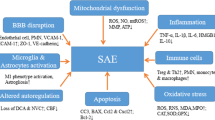Abstract
Acute mitochondriopathy and encephalopathy syndrome (AMES) is described differently by different authors in the literature. As a new clinical entity, we aimed to present the clinical signs and symptoms, diagnosis and treatment algorithm of our patients with AMES. 56 patients aged between 2 months and 18 years who were followed up in pediatric intensive care units of Konya Training and Research Hospital and Selcuk University Medical Faculty Hospital, between January 2010 and June 2017 were included. Patients’ data were obtained retrospectively from the intensive care unit patient files. 34 (60.7%) of the patients were male and 22 (39.3%) were female. The median age of our patients was 10.0 months. At the time of admission, 42 (75%) of the patients had fever, 35 (62.5%) vomiting, 27 (48.2%) abnormal behaviour and agitation and 28 (50%) convulsion. The etiological classification of patients with AMES was divided into four groups as infection, metabolic disorder, toxic, and hypoxic-ischemic. 39 (69.6%) patients were found to have infection, 10 (17.9%) patients hypoxia, 7 (12.5%) patients metabolic disorders. AMES occurs rarely, but should be kept in mind in the differential diagnosis of patients with any encephalopathy of unknown origin especially in those with a history of ingestion of drugs, previous viral infection and vomiting. Early recognition and treatment is imperative to reduce morbidity and mortality in children with AMES.

Similar content being viewed by others
References
Reye RDK, Morgan G, Baral J (1963) Encephalopathy and fatty degeneration of the viscera: a disease entity in childhood. Lancet 2:749–752
Brain WR, Hunter D, Turnbull HM (1929) Acute meningo-encephalomyelitis of childhood: report of 6 cases. Lancet 1:221–227
Waldman RJ, Hall WN, McGee H, van Amburg G (1982) Aspirin as a risk factor in Reye’s syndrome. J Am Med Ass 247:3089–3094
Orlowski JP, Gillis J, Kilham HA (1987) A catch in the Reye. Pediatrics 80:638–642
Smith TCG (1996) Reye’s syndrome and the use of aspirin. Scott Med J 41:4–8
Schror K (2007) Aspirin and Reye syndrome: a review of the evidence. Pediatr Drugs 9:195–204
Devulapalli CS (2000) Rotavirus gastroenteritis possibly causing Reye syndrome. Acta Pediatr 89:613–619
Mizuguchi M, Yamanouchi H, Ichiyama T, Shiomi M (2007) Acute encephalopathy associated with influenza and other viral infections. Acta Neurol Scand Suppl 186:45–56
Leonard JV, Schapira AHV (2000) Mitochondrial respiratory chain disorders I: mitochondrial DNA defects. The Lancet 355:299–304
Starko KM, Ray CG, Dominguez LB, Stromberg WL, Woodall DF (1980) Reye’s syndrome and salicylate use. Pediatrics 66:859–864
Baldellou Va`zquez A (2003) Reye’s syndrome. Forty years later. An Pediatr 59:319–322
Glasgow JFT, Middelton B (2001) Reye syndrome-insights on causation and prognosis. Arch Dis Child 85:351–353
Togashi T, Matsuzono Y, Itakura O, Narita M (1999) IL-6 and TNF-a in cerebrospinal fluid from infantile encephalitis encephalopathy patients during influenza seasons. J Jpn Pediatr Soc 103:16–19
Ichiyama T, Endo S, Kaneko M, Isumi H, Matsubara T, Furukawa S (2003) Serum cytokine concentrations of influenza associated acute necrotizing encephalopathy. Pediatr Int 45:734–736
Morishima T (2003) Studies on the epidemiology and pathogenesis of encephalitis/encephalopathy occurring during the clinical course of influenza. In: 2000–2002 General Report of the Research Committee for Research on Emerging and Re-emerging Diseases. Ministry of Health, Labour and Welfare of Japan, Tokyo, pp 1–23 (in Japanese)
Weiner DL et al (2012) Medscape, Reye Syndrome
Mohnike K, Starke I, Bannert N, Heise HR (1993) Differential diagnosis and therapy of hypoglycemia in childhood. Kinderarztl Prax 61:192–201
Chang PF, Huang SF, Hwu WL, Hou JW, Ni YH, Chang MH (2000) Metabolic disorders mimicking Reye’s syndrome. J Formos Med Assoc 99:295–299
Visentin M, Salmona M, Tacconi MT (1995) Reye’s and Reye-like syndromes, drug-related diseases? (causative agents, etiology, pathogenesis, and therapeutic approaches). Drug Metab Rev 27:517–539
Gill RQ, Sterling RK (2001) Acute liver failure. J Clin Gastroenterol 33:191–198
Wulur H, Kho LK (1990) Treatment of Reye’s syndrome at Sumber Waras Hospital. Acta Paediatr Jpn 32:435–442
Brunner RL, O’Grady DJ, Partin JC, Partin JS, Schubert WK (1979) Neuropsychologic consequences of Reye syndrome. J Pediatr 95:706–711
Devivo DC (1978) Reye syndrome: a metabolic response to an acute mitochondrial insult? Neurology 28:105–108
Devivo DC, Keating JP (1976) Reye’s syndrome. Adv Pediatr 22:175–229
Lemberg A, Fernández MA, Coll C, Rosello DO, Romay S, Perazzo JC et al (2009) Reyes’s syndrome, encephalopathy, hyperammonemia and acetyl salicylic acid ingestion in a city hospital of Buenos Aires, Argentina. Curr Drug Saf 4:17–21
Funding
None.
Author information
Authors and Affiliations
Contributions
All authors contributed to revising critically the final version of the manuscript. Interpretation of data and revising of manuscript: ŞA, FA. Study conception and design: AY. Preparation of manuscript: AY, FA. Literature review: ŞA, Review and supervision of manuscript: AS.
Corresponding author
Ethics declarations
Conflict of interest
All authors declare that they have no conflict of interest.
Ethical approval
The ethics committee approval for the study was received from the ethical committee of Selcuk University (2018/01).
Informed consent
Informed consent was obtained from all individual participants included in the study.
Additional information
Publisher’s Note
Springer Nature remains neutral with regard to jurisdictional claims in published maps and institutional affiliations.
Rights and permissions
About this article
Cite this article
Arslan, Ş., Yorulmaz, A., Sert, A. et al. Management of acute mitochondriopathy and encephalopathy syndrome in pediatric intensive care unite: a new clinical entity. Acta Neurol Belg 120, 1115–1121 (2020). https://doi.org/10.1007/s13760-019-01125-3
Received:
Accepted:
Published:
Issue Date:
DOI: https://doi.org/10.1007/s13760-019-01125-3




